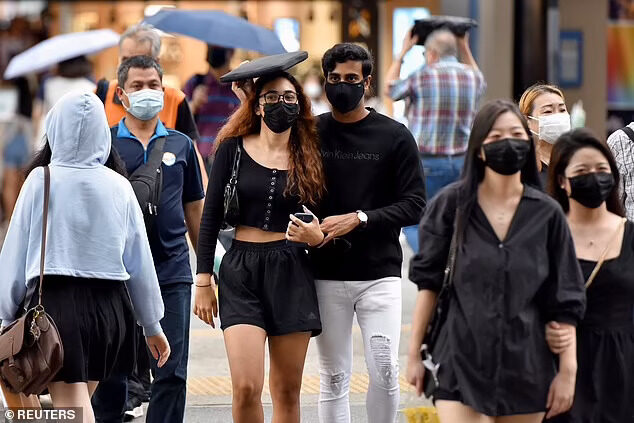
- Covid cases in Singapore and New Zealand have overtaken Australia per capita
- Both still have very strict mandates in place unlike Australia where rules eased
- Death rates in New Zealand are also higher than in Australia despite masks
- Data shared by infectious diseases professor in post saying masks 'don't matter'
- It's the latest damning data to counter calls for a Covid clampdown in Australia
Masks are worn everywhere in the densely-populated Asian city while New Zealanders are forced to wear them in all indoor public places, such as shopping centres and libraries.
But both now have higher case numbers per million than Australia, where compulsory mask rules have been abandoned in most indoor settings.
These figures appear to smash the push now on in Australia for a return to mask mandates, which are currently compulsory only on public transport and in aged care and healthcare centres.
Since Australian mandates began to ease last October, per capita case numbers in Singapore exceeded, matched or lagged behind Australia, before rising ahead again.
In New Zealand, case numbers were six weeks behind Australia's Omicron wave in January, but since February they have matched or exceeded Australia.
Death rates in New Zealand also overtook Australia per capita at the start of March, despite the Kiwis being on the highest code red mask mandate restrictions - and have stayed higher ever since.
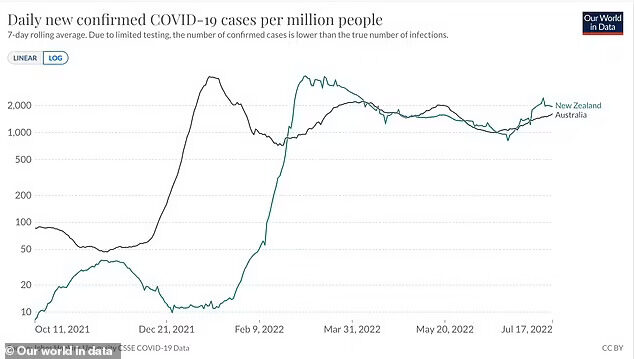
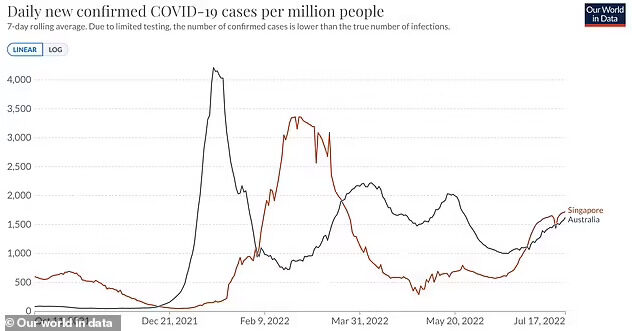
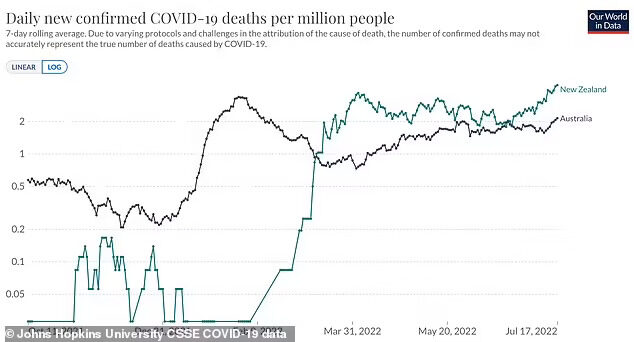
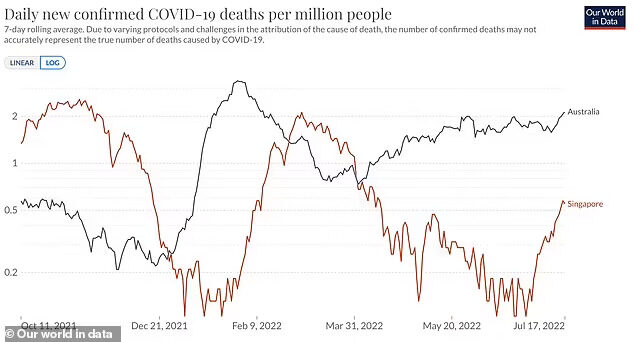
The Singapore findings were shared on Twitter by Australian National University infectious diseases professor Peter Collignon as debate rages on the need for masks.
The post, originally made by a Singapore resident, added:
'Singapore has never dropped its mask mandates. Masks are required indoors at all times.Next to a graph of the statistics, he added: 'It doesn't matter.'
'Australians aren't wearing masks much at all. Let's compare the data.'
The data has been revealed as Victorian children over the age of eight are now asked to wear a mask in classrooms until the end of winter amid a spike in cases.
The state government has insisted the new advice is not a mask mandate, with students encouraged to wear a mask indoors and on public transport.
Parents have described the new rules as a 'mandate by stealth' but former Labor Leader Bill Shorten said kids should be encouraged to wear masks where possible.
'We've had 300 days of home-schooling, and the schools closed,' he told Karl Stefanovic during an appearance on the Today Show on Tuesday morning.NSW and Victorian health ministers have both so far resisted the growing calls for a return to mask mandates, but critics say the looming state elections in October and November are the main reason behind any delay in bringing them back.
'To me it's a no-brainer, do you want your child sick at home or do you want them running around wearing a mask?' the father of one said.
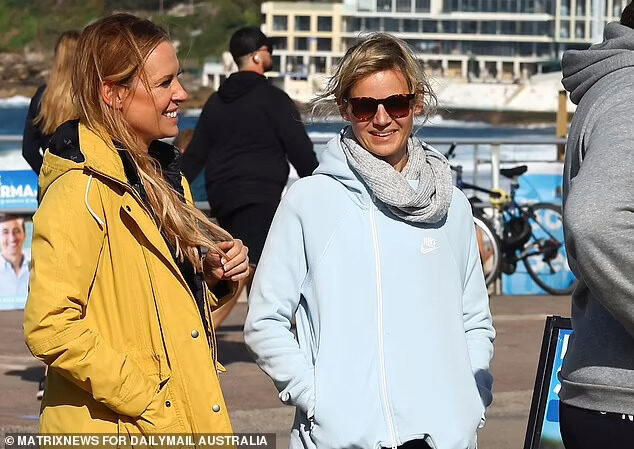
The federal health department's latest Covid report explodes the myths being used to drive Australian authorities to re-introduce mask mandates and continue having Covid cases isolate for seven days.
The data comes as St Vincent's Hospital in Sydney said they have just 'one or two' patients in ICU - with top doctors confirming the winter wave is far less severe than those to have previously hit Australia.
'We certainly don't have many,' confirmed a hospital spokesman on Monday.The vast majority of those who have caught Covid are under 50, with 3,121,953 cases so far. Just 293 people under 50 have died of the virus since the pandemic began.
'It's not presenting so much on the very acute side, where patients need ventilation.'
The statistics show that since Australia's mass vaccination rollout began, those under 50 face a less than one in 10,000 chance of dying from Covid.
'The median age of all those infected is 31 ... [but] the median age of those who died is 83,' the latest federal health department 'Coronavirus At A Glance' reportstates.Australia's average life expectancy is 82.9 years of age.
Most killed by Covid were men over 70 and women over 80, accounting for 7,585 deaths out of the nation's total virus death toll of 10,582 as of 3pm on Friday.
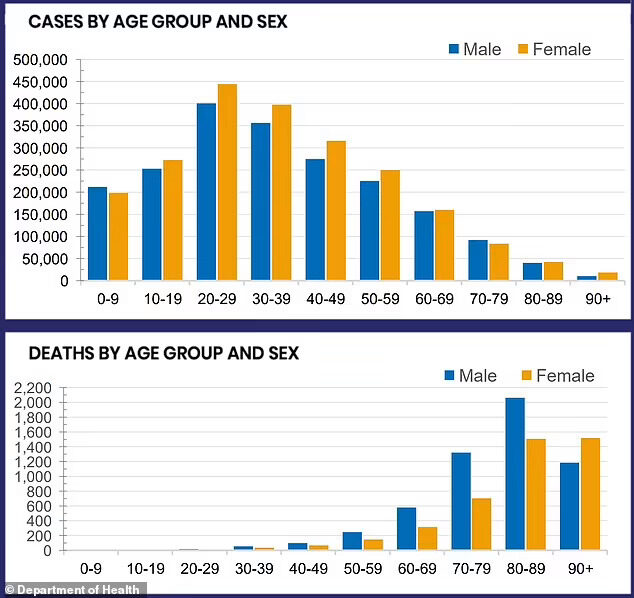
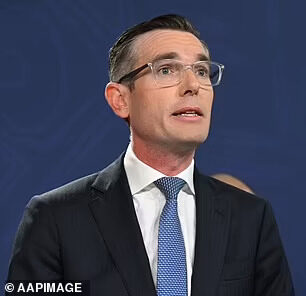
Of the 63,875 who caught Covid in Australian aged care centres, 60,771 recovered, with less than 1 in 20 of infected residents dying, for a tragic toll of 3,104.
NSW Premier Dom Perrottet admitted on Monday that the current flu wave was now a bigger threat than Covid.
'At the moment, the current strand of influenza is more severe than the current strands of COVID,' he told 2GB.As we move through the next phase of the pandemic, we need to balance up the competing health issues.'
The official figures come as pressure grows for a return to compulsory masks ahead of a feared new outbreak of the virulent new Omicron subvariants BA.4 and BA.5.
Doomsday modelling by the Burnet Institute for the NSW government last year said the state's health system could cope with up to 947 Covid patients in ICU.
But NSW currently has just 64 Covid cases in ICU across the state with only 13 on ventilators, according to NSW Health.
The stats have also destroyed claims that Omicron is super-infectious, with infection rates staying constant all year long.
Australia's Omicron BA.1 and BA.2 outbreak, which started in January, coincided with the end of most mask mandates and lockdown restrictions.
Omicron BA.2's R0 - the number of people one person can infect without restrictions - is said to be around 13.3.
But the Re - the effective rate of infection - has stayed around 1 or less since the middle of January, after a brief spike to 2.0 for a couple of days after New Year.
The government's mass double-jab vaccination program, taken up by 95 per cent of the population, has played a huge part in controlling the spread of the virus.
Comment: Vaccination of 95 per cent of the population, has played a huge part in increased sudden deaths of young and healthy people from blood clots and strokes. Also, they play a huge part in myocarditis and pericarditis cases, especially among the young population.
The claims that mRNA Covid vaccines helped in the fight against Covid-19 is just a lie and manipulation with fear of the people so that can get jabbed with these very dangerous experimental mRNA shots.
But the subsequent third booster shot program has been less successful , with just a 71 per cent take up, as work now starts on encouraging a fourth jab.
Comment: The mRNA vaccine efficiency is almost nonexistent. It is all just a myth based on lies and falsified reports.

NSW schools have suffered a 30 per cent rise in staff shortages through sickness as a result of Covid and flu this year, Ms Mitchell said.
'We are absolutely feeling the pressure...there's no question of that,' she admitted.Victoria chief health officer Ben Cowie told the state government to bring back masks, but the advice was rejected by state health minister Mary-Anne Thomas.

'I made a decision based on the advice that I had received that further mandating masks was not the most effective way to get the message out about the importance of mask wearing,' she said.South Australia would need to declare another state emergency, after allowing the last announcement to expire, before they could issue any new mask mandate.
Comment: Masks do not offer any protection from viruses. In fact, long-term mask wearing can have many negative health effects.
Federal health minister Mark Butler also says it is 'unlikely' the government will enforce compulsory masks, but urged people to wear them in public and to work from home where possible.
But Deakin University's Professor Catherine Bennett insists compulsory masks will ease the coming Covid wave and also play a major psychological role.
When you put a mask on, it's a reminder that things aren't quite normal. It reinforces behaviours like taking a step back from other people,' she told Seven West media.
'The mask could be the thing that also helps us stay mindful of those other things ... and stay that bit safer.'
Comment: Maybe that is the main reason that people are forced to wear masks, not for any kind of protection. They want people to live in constant fear that they could die from a virus. It is a classic defocusing method to distract people from the really important things while the PTB are accumulating more power in resources and destroying our lives and economy.
The stats also revealed NSW has had the most Covid cases in Australia with 2,971,525 and 3,798 deaths. Victoria has had the most deaths with 4,148 from 2,245,301 cases.
Northern Territory has had the least number of cases and deaths with 53 deaths from 83,684 infections, ahead of even ACT which has had 84 deaths from 175,923 cases.
The nation has also just passed the 75million milestone for the number of Covid test results since the pandemic began, almost three each for every single person.
AUSTRALIA KEEPS SEVEN-DAY ISOLATION AS WORLD MOVES ON
Australia is doubling down on mandatory isolation as other countries around the globe move towards abandoning them altogether - and it's costing taxpayers $800million.
Prime Minister Anthony Albanese came under fire last week for back-flipping on a decision to scrap $750-a-week payments for casual workers and people without sick leave benefits who are forced into isolation for seven days.
He was pressured to bring back the payments after refusing to budge on mandatory isolation, and encouraged people to wear face masks.
However, the UK, Spain, Denmark, Sweden, Norway, Estonia, Lithuania and Switzerland no longer have isolation, while positive cases are only 'recommended' to self-quarantine for five days in the United States.
Countries such as Sweden no longer categorise Covid as a 'critical illness'.
Mr Albanese argued the isolation period was necessary to combat surging Covid cases and ease pressure on hospitals, despite a large portion of the strain coming from influenza cases.
In the 24 hours to Friday morning, 43,491 new cases of Covid were reported across Australia. There were 65,770 confirmed cases of the flu within the same period.
There is no mandatory isolation period for influenza, and no payments for casual workers off sick with the flu.
Former deputy chief medical officer Nick Coatsworth said on Monday that government officials calling for the reintroduction of mask mandates need to 'move on'.
'Anyone advocating for mandates needs to move on from that because unless significant things change with ... the way this virus behaves, we're not going to be bringing in restrictions or mandates,' he told Sky News.
Dr Coatsworth said antiviral medication and booster shots were significantly more effective than face masks.
Mr Albanese had earlier said the $750-a-week pandemic leave disaster payment would not be reinstated past June 30.
However, he announced on Saturday that it would be made available again from Wednesday and would extend to September 30.
NEW ZEALAND'S GREAT COVER-UP
New Zealanders are told to wear a mask whenever they leave home. The country has a traffic light system of restrictions and was on code red until April when it moved to code orange.
Under code red, Kiwis had to wear masks at universities and colleges and in schools from Year 4 up, and when visiting early learning centres.
Masks also had to be worn in public places like shops, shopping malls, cafes, bars, restaurants, libraries, hairdressers and beauty salons.
All indoors events and indoor gatherings needed to be masked up,
Masks also need to be worn on domestic flights, taxis, ride-sharing cars and public transport, plus healthcare, judicial, remand and aged care centres.
But masks don't need to be worn outdoors or while exercising.
Since April, masks are not now needed in schools, indoor events, museums and libraries or at hospitality venues, but must still be worn everywhere else.
The country is tipped to return to code red on Thursday as NZ case numbers surge.
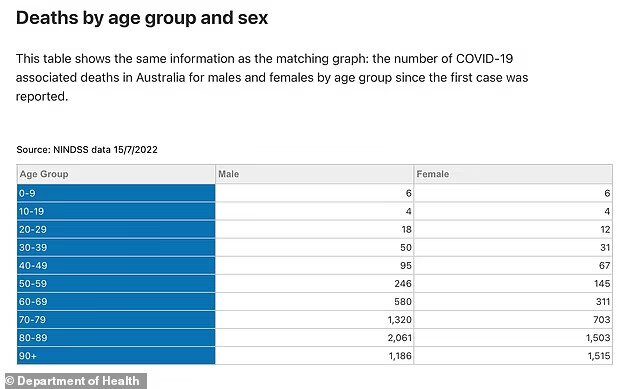




ffs.. stupid is as stupid fkn does.. baah baah baah....sheeple to dumb to realize there a fkn joke!!
im not vaxxed, never wore a mask ever anywhere, been ostricized, abused, and they all can fuk off
i have heart issues, lung copd smoke, and dont give a fuk, il outlive all of the sheep, this a fact!!